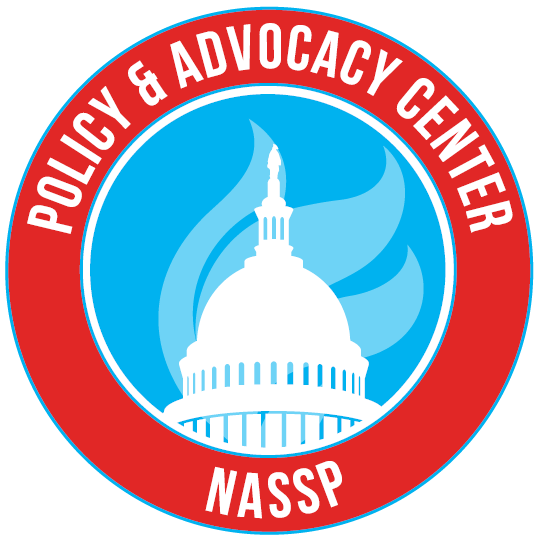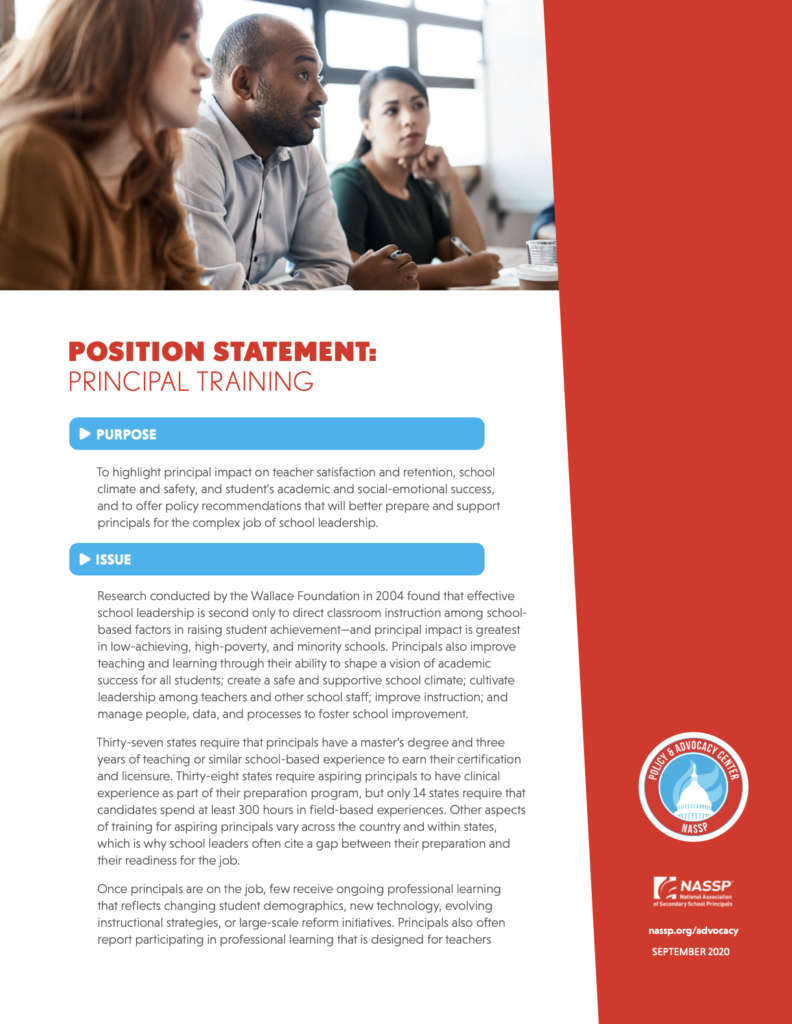
Purpose: To highlight principal impact on teacher satisfaction and retention, school climate and safety, and student’s academic and social-emotional success, and to offer policy recommendations that will better prepare and support principals for the complex job of school leadership.
Research conducted by the Wallace Foundation in 2004 found that effective school leadership is second only to direct classroom instruction among school-based factors in raising student achievement—and principal impact is greatest in low-achieving, high-poverty, and minority schools. Principals also improve teaching and learning through their ability to shape a vision of academic success for all students; create a safe and supportive school climate; cultivate leadership among teachers and other school staff; improve instruction; and manage people, data, and processes to foster school improvement.
Thirty-seven states require that principals have a master’s degree and three years of teaching or similar school-based experience to earn their certification and licensure. Thirty-eight states require aspiring principals to have clinical experience as part of their preparation program, but only 14 states require that candidates spend at least 300 hours in field-based experiences. Other aspects of training for aspiring principals vary across the country and within states, which is why school leaders often cite a gap between their preparation and their readiness for the job.
Once principals are on the job, few receive ongoing professional learning that reflects changing student demographics, new technology, evolving instructional strategies, or large-scale reform initiatives. Principals also often report participating in professional learning that is designed for teachers rather than their own learning needs. “And when they do participate in principal-focused professional development, it is largely centered on the ‘what’ of district reform, such as what is expected for district teacher evaluation policies, and not on the ‘how’ of leading change,” according to the Education Policy Center at American Institutes for Research.
Guiding Principles
- NASSP seeks to transform education through school leadership, recognizing that the fulfillment of each student’s potential relies on great leaders in every school committed to the success of each student.
- Highly effective school leadership strategically, collaboratively, and purposefully equips, encourages, empowers, and drives each individual in the school community to reach their highest potential.
- Building Ranks™: A Comprehensive Framework for Effective School Leaders translates educational leadership standards into an actionable framework that promotes the academic, social, emotional, and physical success of each student by building culture and leading learning.
- What the Research Shows: Building Ranks™ in Action confirms the importance of developing and investing in the professional learning of school leaders at all levels. Further, it provides curated research on a broad range of topics that can guide district leaders, professional learning and preparation programs, and policymakers as they make those needed investments in building the capacity of school leaders.
- The Professional Standards for Educational Leaders (PSEL) are organized around the domains, qualities, and values of leadership work that research and practice indicate contribute to students’ academic success and well-being. These aspiring standards are for all practicing principals.
- The National Educational Leadership Preparation (NELP) standards, which are aligned to the PSEL, provide specificity around performance expectations for beginning-level building and district leaders. Where the PSEL standards define educational leadership broadly, the NELP standards specify what novice leaders and program graduates should know and be able to do as a result of completing a high-quality educational leadership preparation program. There is one set of NELP standards for candidates preparing to become principals and a second set of standards for candidates seeking to become superintendents.
- NASSP previously adopted a position statement on culturally responsive schools in order to highlight the changing demographics of the K–12 student population and offer recommendations for policymakers and school leaders on how to create culturally responsive schools that will allow each student to succeed.
Recommendations
Recommendations for Federal Policymakers
- Fully fund Title II, Part A of the Every Student Succeeds Act (ESSA), which provides resources for states and districts to strengthen teacher and principal preparation programs, reform educator certification and licensure requirements, develop career advancement initiatives for teachers, and offer professional learning opportunities for teachers and school leaders.
- Research principal professional learning and provide support and technical assistance to states and districts to help them incorporate best practices into their education systems.
- Continue the ongoing collection of Title II, Part A data to ensure that states and districts are implementing programs consistent with ESSA and to help stakeholders determine the effectiveness of these investments in improving school leadership.
- Reauthorize the Higher Education Act and ensure that all principal preparation programs are held to the same high standards and include strong clinical training; rigorous requirements and training for mentors; and ongoing mentoring and support for new educators, which research shows increase educator retention and effectiveness.
- Incentivize the development of school leader residency programs to provide a full year of clinical training in partner districts and subsidize aspiring principals’ salaries.
- Conduct research and provide guidance for principals on how to balance targeting supports for students in the areas of social, emotional, physical, and safety aspects of wellness.
Recommendations for State Policymakers
- Adopt or adapt the PSEL and NELP standards to ensure that principal certification and licensure requirements are aligned to the domains, qualities, and values of leadership that empower each individual to apply the knowledge, skills, and dispositions to grow and contribute productively in a global society.
- Use the allowable 3 percent reservation of Title II funds under ESSA to strengthen the content of preparation programs and professional learning opportunities for principals, including through partnerships with nonprofit organizations, to help all principals be highly effective school leaders.
- Require school districts to report how they use Title II funds to build their capacity to better support and train principals and aspiring principals.
- Revise licensure, certification, and principal preparation program accreditation requirements to ensure aspiring principals spend at least 250 hours in field-based experiences—which is consistent with NELP standards—and incentivize the creation of school leader residencies.
- Incentivize institutions of higher education to create and expand principal preparation programs that emphasize:
- Strong district partnerships
- Leadership skills with a demonstrated impact on student and school success, including the ability to create a continuous learning environment for teachers, staff, and students
- Rigorous recruitment and selection criteria for successful educators who have shown potential as leaders
- Instructors with prior school leadership experience and deep knowledge of effective leadership practices
- Comprehensive clinical experiences that are linked to coursework and help principal candidates address context-specific problems and the needs of special population groups, including students with disabilities, English-language learners, and students from economically disadvantaged families
- Peer networks
- High-quality mentoring, supervision, and evaluation of candidates throughout the clinical experience
- Opportunities for ongoing professional learning and coaching for practicing school leaders
- Provide funding for principal candidates to receive a competitive salary and benefits while participating in their preparation program and field experiences.
- Ensure that data systems link teacher evaluations and student performance data back to principal preparation programs so that policymakers and institutions of higher education can identify best practices and growth opportunities.
Recommendations for District Leaders
- Communicate explicit expectations for principal leadership and ensure that professional development, mentoring, and ongoing support for principals are aligned to these expectations and link to school or district mission and needs.
- Develop partnerships with principal preparation programs that include genuine engagement and incorporate district needs into the recruitment, training, and clinical experiences.
- Ensure that principals receive ongoing mentoring and support from individuals who have been successful school leaders and are trained and compensated to be successful.
- Provide training for principal supervisors to develop their capacity to support and coach principals as instructional leaders.
- Engage principals in a formal evaluation process and use evidence of principals’ effectiveness and student achievement to develop continuous professional learning opportunities that reflect individual school and leader needs.
- Provide professional development opportunities for principals that are aligned to PSEL standards and focused on those skills proven to affect teacher and student outcomes.
- Develop frameworks that support the recruitment, development, and retention of strong school leaders.
Recommendations for School Leaders
- Engage in self-reflection to understand how your practice as a school leader contributes to a supportive environment focused on student and adult learning.
- Identify and pursue continuous learning opportunities related to your areas of strength and growth, including collaboration with other principals to share best practices and form support networks.
- Educate yourself about Title II and other sources of funding for professional learning opportunities, and be an advocate for additional resources to support your continued professional development.
- Invite staff, parent, and student feedback and demonstrate a willingness to accept and act on the recommendations, and set the expectation that other staff members will do the same.
- Leverage research to help translate standards and the dimensions and strategies of the Building Ranks framework into practice.
- Familiarize yourself with the complexity of your role as you attend to the interdependence of building culture and leading learning in your unique school context.
Resources
Anderson, E. & Reynolds, A. (2015). A policymaker’s guide. Research-based policy for principal preparation program approval and licensure. Charlottesville, VA: University Council for Educational Administration.
Education Commission of the States. (2018). 50-state comparison: School leader certification and preparation programs. Retrieved from https://www.ecs.org/50-state-comparison-school-leader-certification-and-preparation-programs/.
George W. Bush Institute. (2016). Following the leaders: An analysis of graduate effectiveness from five principal preparation programs. Retrieved from https://gwbcenter.imgix.net/Resources/gwbi-grad-effectiveness-principal-prep.pdf.
Goldring, E., Grissom, J., Rubin, M., Rogers, L., Neel, M., & Clark, M. (2018). A new role emerges for principal supervisors: Evidence from six districts in the principal supervisor initiative. New York, NY: The Wallace Foundation.
Krasnoff, B. (2015). Leadership qualities of effective principals. Portland, OR: Education Northwest.
Leithwood, K., Louis, K.,Anderson, S., & Wahlstrom, K. (2004). How leadership influences student learning. Review of the research. New York, NY: The Wallace Foundation.
Mendels, P. (2012). The effective principal. Retrieved from https://www.wallacefoundation.org/knowledge-center/Documents/The-Effective-Principal.pdf.
National Association of Secondary School Principals (2018). Building Ranks™: A comprehensive framework for effective school leaders. Retrieved from https://www.nassp.org/professional-learning/building-ranks-for-school-leaders/
National Association of Secondary School Principals (2019). What the research shows: Building ranks in action. Retrieved from https://www.nassp.org/professional-learning/building-ranks/
National Association of Secondary School Principals and National Association of Elementary School Principals (2013). Leadership matters. Retrieved from https://www.naesp.org/sites/default/files/LeadershipMatters.pdf.
National Policy Board for Educational Administration (2018). National educational leadership preparation (NELP) program standards – building level. Retrieved from www.npbea.org.
National Policy Board for Educational Administration (2015). Professional standards for educational leaders. Reston, VA.
Rowland, C. (2017). Principal professional development: New opportunities for a renewed state focus. Washington, D.C.: Education Policy Center at American Institutes for Research. Retrieved from http://www.air.org/sites/default/files/downloads/report/Principal-Professional-Development-New-Opportunities-State-Focus-February-2017.pdf
Siddiqi, J., Sims, P., & Goff, A. (2018). Meaningful Partnerships. Lessons learned from two innovative principal preparation programs. Durham, NC: The Hunt Institute.
Sutcher, L., Podolsky, A., & Espinoza, D. (2017). Supporting principals’ learning. Key features of effective programs. Palo Alto, CA: Learning Policy Institute.
Wang, E., Gates, S., Herman, R., Mean, M., Perera, R., Tsai, T., Whipkey, K., & Andrew, M. (2018). Launching a redesign of university principal preparation programs. Santa Monica, CA: RAND Corporation.

